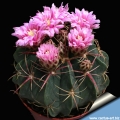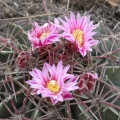Accepted Scientific Name: Ferocactus macrodiscus (Mart.) Britton & Rose
Cactaceae (Britton & Rose) 3: 139, fig. 147. 1922 Britton & Rose

Echinocactus macrodiscus (Ferocactus macrodiscus) Photo by: Agócs György
In habitat partially burried in the ground. Mexico.
Origin and Habitat: Ferocactus macrodiscusSN|4317]]SN|4317]] is endemic to Mexico, and is distributed in the states of Guanajuato and Oaxaca, and has a disjunct distribution. Anderson (2001) and Arias et al. (1997) report it also from from Querétaro and San Luis Potosí (extent of occurrence <2,000 km2). The species is known from less than 10 locations.
Altitude range: The species occurs at elevations of 2,300 - 2,600 metres above sea level.
Habitat: Ferocactus macrodiscusSN|4317]]SN|4317]] is very habitat specific and only occurs sporadically within the extent of occurrence. It occurs in a very dry area in grasslands and oak (Quercus) forest in association with Tillandsia usneoidesSN|28167]]SN|28167]], bushes and desert trees. During drought periods the plants sink well into the ground, from the effects of heat and dryness. For this reason it is very difficult to locate the cactus until the rains arrive and it swells itself and prepares to bloom. If it is not flowering, it would be difficult to see it at all. The primary threat to this species is the destruction of habitat from the conversion of grasslands and oak forests to subsistence mixed agriculture and cattle ranching. Some subpopulations are in a steep decline.
Synonyms:
See all synonyms of Ferocactus macrodiscus
Common Names include:
ENGLISH: Candy cactus, Barrel cactus
SPANISH (Español): Biznaga de Dulce
SWEDISH (Svenska): Platt djävulstunga
Description: Ferocactus macrodiscusSN|4317]]SN|4317]] is a medium sized barrel cactus with a depressed-globose stem and blue-green epidermis. Growth from seed is quite rapid and plants will flower when only a few cm across. Flowers are white with pinkish-purple striped petals. Two subspecies are recognized, the nominate form and subsp. septentrionalis (J.Meyrán) N.P.Taylor.
Stem: Solitary, flat, depressed-globose, or disc-shaped up to 10 cm tall and 30-45 cm in diameter (but up to nearly 60 in some cases).
Ribs: (13-)16 to 21(-35), somewhat flattened, sometimes acute on the margin, somewhat depressed at the distant areoles.
Areoles: 5 to 10 mm long with yellow felt sunken in notches in the ribs.
Spines: Yellow or red and curved.
Central spines: 1 to 4 (of which one longer and pointing downward), up to 3,5 cm long, stouter and flatter than the radials, often banded.
Radial spines: 6 to 8, more or less curved backward, 2-3 cm long.
Flowers: Obconic,, 3-4(-5) cm long and about 3-4 cm in diameter. Inner perianth-segments linear-oblong, acute bright purple/pink with pale margins. Stamens and style included.
Blooming season: Spring to summer. In habitat it flowers between April and July.
Blooming season: From early spring into summer.
Fruits: Nearly spherical, to 4 x 3 cm, red.
Seeds: To 2 mm, dark brown, finely pitted.
Similar species. Ferocactus macrodiscusSN|4317]]SN|4317]] closely reminds {Homalocephala texensesis}} which has dense wool in the axils of the scales of the ovary, and the seeds are large and smooth, on the contrary the ovary of Ferocactus macrodiscusSN|4317]]SN|4317]] has naked axils of the scales and the seeds are smaller and pitted. In spite of these and other differences, F. macrodiscus appears to be nearly as closely related to Homalocephala texensis and F. macrodiscus may represent transitional forms between Ferocactus and Echinocactus, although Homalocephala is generally considered to be a side development from Echinocactus.
Subspecies, varieties, forms and cultivars of plants belonging to the Ferocactus macrodiscus group
 Ferocactus macrodiscus (Mart.) Britton & Rose: The 'macrodiscus' subspecies has a blue-green epidermis and areoles 0,5 to 1 cm long. The spines are yellow or red and curved. It is the most prevalent.
Ferocactus macrodiscus (Mart.) Britton & Rose: The 'macrodiscus' subspecies has a blue-green epidermis and areoles 0,5 to 1 cm long. The spines are yellow or red and curved. It is the most prevalent.- Ferocactus macrodiscus var. septentrionalis J.Meyran: The 'septentrionalis' subspecies has a greenish-yellow epidermis and the areoles are 1,5 to 2,5 cm long. The spines are straight and strong.
Bibliography: Major references and further lectures
1) Sánchez , E., Bárcenas Luna, R., Hernández, H.M., Gómez-Hinostrosa, C. & Cházaro, M. 2013. Ferocactus macrodiscus. The IUCN Red List of Threatened Species 2013: e.T152288A619356. http://dx.doi.org/10.2305/IUCN.UK.2013-1.RLTS.T152288A619356.en. Downloaded on 25 April 2016.
2) Edward Anderson “The Cactus family” Timber Press, Incorporated, 2001
3) James Cullen, Sabina G. Knees, H. Suzanne Cubey "The European Garden Flora Flowering Plants: A Manual for the Identification of Plants Cultivated in Europe, Both Out-of-Doors and Under Glass" Cambridge University Press, 11/Aug/2011
4) David R Hunt; Nigel P Taylor; Graham Charles; International Cactaceae Systematics Group. "The New Cactus Lexicon" dh books, 2006
5) N. L. Britton, J. N. Rose “The Cactaceae. Descriptions and Illustrations of Plants of the Cactus Family.” Volume 4, The Carnegie Institution of Washington, Washington 1923
6) Arias, M.S., Gama, S. and Guzmán, U. “Flora del Valle de Tehuacán-Cuicatlán”. Fasículo 14. Cactaceae A.L. Juss. Instituto de Biología, UNAM, Mexico. 1997
7) Hernández, H. and Godínez, H. “Contribución al conocimiento de cactáceas mexicanas amenazadas.” Acta Botánica Mexicana 26: 33-52.1994
8) Hernández, H.M., Gómez-Hinostrosa, C. and Goettsch, B. “Checklist of Chihuahuan Desert Cactaceae.” Harvard Papers in Botany 9(1): 51-68. 2004
9) George Edmund Lindsay, J. Hugo Cota “The taxonomy and ecology of the genus Ferocactus: explorations in the USA and Mexico” Tireless Termites Press, 1996
10) Kakteen and andere Sukkulenten 29: 65-6, f. 1-5 (1978)
11) Bradleya 2: 26 (1984)
12) Hiroshi Hirao “Colour encyclopaedia of cacti” Japan 1979 (Japanese language and script)
 Echinocactus macrodiscus (Ferocactus macrodiscus) Photo by: Valentino Vallicelli
Echinocactus macrodiscus (Ferocactus macrodiscus) Photo by: Valentino Vallicelli - Unusual in Collections it starts blooming when the plant has only a diameter of 8-12 cm. In its habitat it passes the dry periods almost buried in the ground. (Ferocactus macrodiscus) Photo by: Andrea B.
- Unusual in Collections it starts blooming when the plant has only a diameter of 8-12 cm. In its habitat it passes the dry periods almost buried in the ground. (Ferocactus macrodiscus) Photo by: Andrea B. Echinocactus macrodiscus (Ferocactus macrodiscus) Photo by: Agócs György
Echinocactus macrodiscus (Ferocactus macrodiscus) Photo by: Agócs György Echinocactus macrodiscus (Ferocactus macrodiscus) Photo by: Cactus Art
Echinocactus macrodiscus (Ferocactus macrodiscus) Photo by: Cactus Art Echinocactus macrodiscus (Ferocactus macrodiscus) Photo by: Peiffer Clement
Echinocactus macrodiscus (Ferocactus macrodiscus) Photo by: Peiffer Clement Echinocactus macrodiscus (Ferocactus macrodiscus) Photo by: Cactus Art
Echinocactus macrodiscus (Ferocactus macrodiscus) Photo by: Cactus Art Echinocactus macrodiscus (Ferocactus macrodiscus) Photo by: Cactus Art
Echinocactus macrodiscus (Ferocactus macrodiscus) Photo by: Cactus Art Echinocactus macrodiscus (Ferocactus macrodiscus) Photo by: Cactus Art
Echinocactus macrodiscus (Ferocactus macrodiscus) Photo by: Cactus ArtCultivation and Propagation: Unlike other Ferocacti that flowers only as large adult, Ferocactus macrodiscusSN|4317]]SN|4317]] will flower at a reasonable size in a small pot in a glasshouse. Slow growing to start from seed, but it does well under cultivation and plants will flower when only a few years old.
Soil: It is suited for any rich, well drained soil (Ph 6).
Exposure. Grow it in full sun throughout the year.
Temperature requirements: In winter keep completely dry at 10°C, but it can tolerate sporadic light frost. Anyhow it's problematic if the temperature goes below 5° with high humidity during the winter rest. Even adult specimens are affected by wounded spots in their epidermis.
Watering needs: It takes less watering than the standard for other ferocacti. It's necessary to be avoid wetting the bodies of these plants while they are in sunlight. A wet cactus in the sun light can cause sun burning, which can lead to scars, or even fungal infections and death.
Pests and diseases: It is apt to undergo attacks of red spiders if it is placed near fruit trees.
Propagation: Seeds are the only way of reproducing.
Uses: Ferocactus macrodiscusSN|4317]]SN|4317]] (The"Candy Cactus") is used to make sweets. The middle is cored out and soaked in sugar, then chopped up and eaten.
Your Photos

by Cactus Art

by Cactus Art

by Cactus Art

by Cactus Art

by Agócs György























